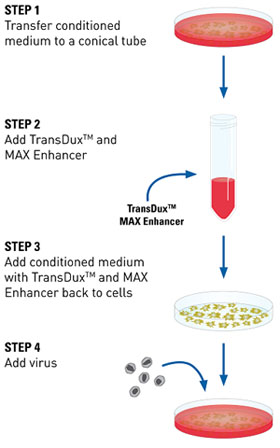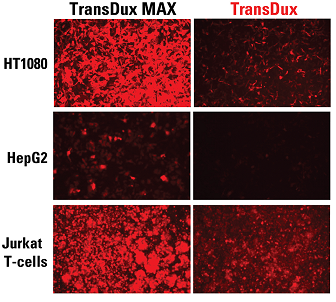TransDux MAX Lentivirus Transduction Enhancer
Product Description
Maximize transduction efficiencies for more reliable and reproducible gene delivery, even in infection-resistant cell types
Building on SBI’s popular TransDux Virus Transduction Reagent (Cat# LV850A-1-SBI),TransDux MAX Lentivirus Transduction Enhancer further increases transduction efficiencies by 4-fold, for better, more reliable lentiviral gene expression across a wide range of cell types and with any lentivector.
- Efficient—up to 8-fold greater transduction efficiency than polybrene, and 4-fold greater efficiency than standard TransDux Virus Transduction Reagent as measured by qPCR*
- Easy-to-use—kit format requires minimal hands-on time (<5 minutes)
- Non-toxic—no need to change out media after infection
- Versatile—works with all types of packaged lentivirus
- Flexible—enhances transduction efficiency in a wide variety of cell lines
- Broadly compatible—does not interfere with downstream gene expression or functional assays
*Based on infection of HT1080 cells with the pre-packaged virus format of BLIV 2.0 reporter MSCV-Luciferase-EF1a-copGFP-T2A-Puro (Cat# BLIV713VA-1-SBI) and the appropriate conditions for polybrene, TransDux, and TransDux MAX. Virus transduction & integration efficiency was measured using the Global UltraRapid Titering Kit (Cat #LV961A-1-SBI)
How it works
TransDux MAX comes in an easy-to-use, two component format (TransDux and MAX Enhancer), good for 100 transduction reactions (One reaction is defined as treating 500 µl of conditioned media in a single well of 24-well plate). Simply mix both reagents into conditioned media from target cells, and infect with your lentivirus of choice for a higher level of transduction efficiency.

Supporting Data
Take your transduction efficiencies to a whole new level

TransDux MAX delivers even higher transduction efficiencies than the original TransDux reagent. SBI’s BLIV713 pre-packaged lentivirus [CMV-Luciferase-EF1a-copGFP-T2A-Puro] was transduced into HT1080 cells using either TransDux MAX, TransDux, or Polybrene. Cells were imaged for GFP expression 72 hours post-infection. (Left panel) Microscopy of transduced cells. (Right panel) qPCR-based quantitation of virus infectivity.
Increase transduction efficiency across a broad range of cell lines

TransDux MAX delivers high transduction efficiencies across a broad range of cell types. Transduction of SBI’s LV605 pre-packaged virus [MSCV-GFP-T2A-RFP] into various cell lines (HT1080, HepG2, and Jurkat T-cells). Cells were imaged for RFP expression 72 hours post-infection.
Product Citations
- Budagyan, K, Cannon, AC & Chernoff, J. (2024) A Facile Method to Append a Bio-ID Tag to Endogenous Mutant Kras Alleles. Methods in molecular biology
- Jiang, C, et al. (2024) General anaesthetics reduce acute lymphoblastic leukaemia malignancies in vitro and in vivo via CXCR4 and osteopontin mediated mechanisms. F1000Research
- Werner, MS, et al. (2024) Adeno-associated virus-mediated trastuzumab delivery to the central nervous system for human epidermal growth factor receptor 2+ brain metastasis. Cancer gene therapy
- Guilz, N, et al. (2023) Replication stress in activated human NK cells induces sensitivity to apoptosis. bioRxiv
- Reddy-Vari, H, et al. (2023) Increased expression of miR146a dysregulates TLR2-induced HBD2 in airway epithelial cells from patients with COPD. ERJ open research
- Catalog Number
LV860A-1-SBI - Supplier
SBI System Biosciences - Size
- Shipping
Blue Ice
You save 10 %
599,00 €
